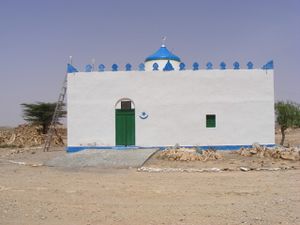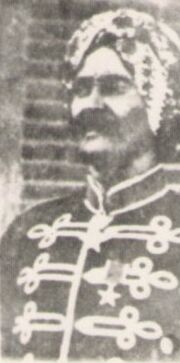دارود
دارود | |
|---|---|
 | |
| المناطق ذات التجمعات المعتبرة | |
| الصومال، إثيوبيا، كينيا | |
| اللغات | |
| Somali | |
| الدين | |
| Islam (Sunni) | |
| الجماعات العرقية ذات الصلة | |
| Dir, Hawiye, Isaaq, Rahanweyn, other Somalis |
قبيلة داروود هي من اكبر قبائل الصومال. The forefather of this clan was Sheikh Abdirahman bin Isma'il al-Jabarti, more commonly known as Darood.[1][2] The clan primarily settles the apex of the Horn of Africa and its peripheries, the Somali hinterlands up to Oromia, and both sides of the Kenya–Somalia border.[3]
وينتمي أغلب زعماء الصومال إلي هذه القبيلة.
الأصول
According to early Islamic books and Somali tradition, Aqeel Abu Talib ibn Abd al-Muttalib Al-Qurashi descendant Abdirahman bin Isma'il al-Jabarti (Darod), a son of the Sufi Sheikh Isma'il al-Jabarti of the Qadiriyyah order, fled his homeland in the Arabian Peninsula after an argument with his uncle.[4][5] During the 10th or 11th century CE,[6] Abdirahman is believed to have then settled in Somaliland just across the Red Sea and married Dobira, the daughter of the Dir clan chief. This union is said to have given rise to the Darod clan family.[7] Thus, it established matrilateral ties with the Samaale main stem.[8]
According to the British anthropologist and Somali Studies veteran Ioan Lewis, the traditions of descent from noble Arab families related to the Prophet are most probably figurative expressions of the importance of Islam in Somali society.[9][10] However, "there is a strong historically valid component in these legends which, in the case of the Darod, is confirmed in the current practice of a Dir representative officiating at the ceremony of installation of the chief of the Darod family."
A similar clan mythology exists for the Sheikh Ishaq ibn Ahmad al-'Alawi, who are said to have descended from one Sheikh Ishaq ibn Ahmad al-'Alawi, another Banu Hashim who came to Somaliland around the same time.[4][6] As with Sheikh Isaaq, there are also numerous existing hagiologies in Arabic which describe Sheikh Darod's travels, works and overall life in northern Somalia, as well as his movements in Arabia before his arrival.[11] Besides historical sources such as Al-Masudi's Aqeeliyoon,[5] a modern manaaqib (a collection of glorious deeds) printed in Cairo in 1945 by Sheikh Ahmad bin Hussen bin Mahammad titled Manaaqib as-Sheikh Ismaa'iil bin Ibraahiim al-Jabarti also discusses Sheikh Darod and his proposed father Isma'il al-Jabarti, the latter of whom is reportedly buried in Bab Siham in the Zabid District of western Yemen.[12]
Sheikh Darod's own tomb is in Haylaan, situated in the Sanaag region of Somaliland, and is the scene of frequent pilgrimages.[13] Sheikh Isaaq is buried nearby in Maydh,[14] as is Sheikh Harti, a descendant of Sheikh Darod and the progenitor of the Harti Darod sub-clan, whose tomb lies in the ancient town of Qa’ableh.
Sheikh Darod's mawlid (birthday) is also celebrated every Friday with a public reading of his manaaqib.[12]
The Darod were supporters of Imam Ahmad ibn Ibrahim al-Ghazi during his 16th century conquest of Abyssinia; especially the Harti, Marehan and Bartire sub-clans, who fought at Shimbra Kure, among other battles.[15] In his medieval Futuh Al-Habash documenting this campaign, the chronicler Shihāb al-Dīn indicates that 300 Harti soldiers took part in Imam Ahmad's Adal Sultanate army. He describes them as "famous among the infantry as stolid swordsmen" and "a people not given to yielding".[16]
فروع القبيلة
تنقسم إلي عدة قبائل منها علي سبيل المثال:
- Geri
- Issak Hassan, Abayoonis Hassan, Omer Hassan and Ika Hume Geri
- مريحان
- Awrtable
- رير علمي محمد
- Ogaden
- Jidwaq
- Bartire
- Absguul
- Yabaree
- Leelkase
- Harti
- Dashiishe
- البر تر
- مريحان (قبيلة محمد سياد بري)
- آبى اسكول
- دول بهنتي
- ورسنجلي
- مجرتين
أماكن تواجدهم
جنوب و غرب الصومال و في مقديشو العاصمة ويرجع نسبهم إلى جبرتي اسماعيل ويقال إن سفينة غرقت قبالة سواحل الصومال فتزوج هناك وأنجب والد سمه هرتي لقب فيما(بدار وود) هرتي بن كومبه بن كبل الله بن عبدالرحمن بن إسماعيل بن عبد الصمد بن علي الجبرتي العقيلي الهاشمي.
نسبهم
وهم من اشراف الحجاز يرجع نسبهم إلى أسلم بن عقيل بن ابي طالب ابن عم الرسول محمد.
الهامش
- ^ Lewis, Ioan M (1999). A Pastoral Democracy: A Study of Pastoralism and Politics Among the Northern Somali of the Horn of Africa. James Currey Publishers. p. 12. ISBN 9780852552803. Retrieved 18 September 2019.
- ^ Lewis, Ioan M (July 1959). "Clanship and Contract in Northern Somaliland". Africa: Journal of the International African Institute. 29 (3): 274–293. doi:10.2307/1157617. JSTOR 1157617. S2CID 143243256. Retrieved 18 September 2019.
- ^ Ethnic Groups (Map). Somalia Summary Map. Central Intelligence Agency. 2002. Retrieved 2012-07-30. Perry–Castañeda Library Map Collection - N.B. Various authorities indicate that the Darod is one of the largest Somali clans [1], whereas others suggest that the Hawiye is the largest Somali clan within Somalia, nevertheless, there is an available census that is been conducted along the lines of clan affiliates [2].
- ^ أ ب Rima Berns McGown, Muslims in the diaspora, (University of Toronto Press: 1999), pp.27-28
- ^ أ ب "Islam in Somali History Fact and Fiction revisited, the Arab Factor". maanhadal.com. Archived from the original on 19 September 2011. Retrieved 6 April 2018.
- ^ أ ب I.M. Lewis, A Modern History of the Somali, fourth edition (Oxford: James Currey, 2002), p. 22
- ^ Somaliland Society (1954). The Somaliland Journal, Volume 1, Issues 1-3. The Society. p. 85.
- ^ Lewis, A pastoral democracy, pp. 11–13.
- ^ I.M. Lewis, A pastoral democracy: a study of pastoralism and politics among the Northern Somali of the Horn of Africa, (LIT Verlag Münster: 1999), pp.128-129
- ^ Lewis, Ioan. M. (1994). Blood and Bone: The Call of Kinship in Somali Society. Larwenceville, NJ: The Red Sea Press Inc. pp. 104–105. ISBN 9780932415936. Retrieved 23 September 2015.
- ^ Roland Anthony Oliver, J. D. Fage, Journal of African history, Volume 3, (Cambridge University Press.: 1962), p.45
- ^ أ ب Lewis, A pastoral democracy, p.131.
- ^ Lewis, Peoples of the Horn of Africa, p.18-19
- ^ I.M. Lewis, "The Somali Conquest of the Horn of Africa", Journal of African History, 1 (1960), p. 219
- ^ Sihab ad-Din Ahmad bin'Abd al-Qader, Futuh al-Habasa: The conquest of Ethiopia, translated by Paul Lester Stenhouse with annotations by Richard Pankhurst (Hollywood: Tsehai, 2003), pp. 50, 76
- ^ Shihāb al-Dīn Aḥmad ibn ʻAbd al-Qādir ʻArabfaqīh, Translated by Paul Stenhouse, Richard Pankhurst (2003). The conquest of Abyssinia: 16th century. Tsehai Publishers & Distributors. p. 77. ISBN 9780972317269.
{{cite book}}: CS1 maint: multiple names: authors list (link)
المصادر
- Hunt, John A. (1951). "Chapter IX: Tribes and Their Stock". A General Survey of the Somaliland Protectorate 1944-1950. لندن: Crown Agent for the Colonies. Accessed on October 7 2005 (from Civic Webs Virtual Library archive).
- "The Somali Ethnic Group and Clan System". Civic Webs Virtual Library, from: Reunification of the Somali People by Jack L. Davies, Band 160 IEE Working Papers, Institute of Development Research and Development, Ruhr-Universität Bochum, Bochum, Germany 1996, ISBN 3-927276-46-4, ISSN 0934-6058. Retrieved January 22.
{{cite web}}: Check date values in:|accessdate=(help); Unknown parameter|accessyear=ignored (|access-date=suggested) (help)

